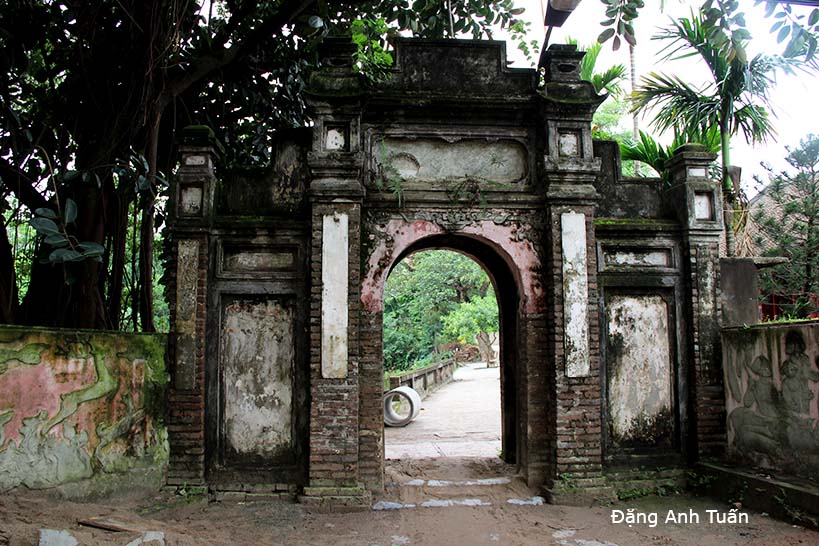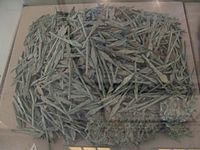
Loa Thành và Huyền Thoại
Thục Quốc Sơn Hà nguyên cổ Việt
Loa Thành cung tẩm sướng tiền Ngô
Sông núi nước Thục vốn là nước Việt xưa
Cung khuyết ở thành Cổ Loa, bắt đầu xây dựng từ thời Ngô Quyền
Les monts et fleuves du royaume Thục appartenaient à l’ancien pays des Vietnamiens.
La porte du palais royal situé dans la citadelle fut édifiée à l’époque de Ngồ Quyền.
Theo truyền thuyết, thành Cổ Loa ban đầu có chín vòng xoắn ốc đất. Đây là lý do tại sao vua An Dương đặt cho nó cái tên « Loa Thành (thành cổ xoắn ốc) ». Trong các cuộc khai quật khảo cổ gần đây, các nhà khảo cổ học Việt Nam và Nhật Bản chỉ tìm thấy sự tồn tại của 3 vòng xoắn ốc. Được xây bằng đất, các vòng xoắn nầy được bao quanh bởi những con hào rộng và được gia cố chắc chắn bằng hàng rào tre. Sự hiện diện của những con hào này và sự củng cố của những vòng xoắn này là minh chứng cho sự hiểu biết hoàn hảo của người dân Việt cổ về điạ hình của vùng đất. Nhờ thế An Dương Vương chống lại anh dũng các cuộc tấn công của người Hoa nhiều lần.
Theo truyền thuyết, tòa thành không thể thất thủ được nhờ chiếc nỏ thần được biếu tặng cho nhà vua bởi con rùa vàng vào thời điểm chia tay. Loa thành chỉ bị thất thủ vào năm 208 nhờ mưu đồ khéo léo của tướng Trung Hoa Triệu Đà thành công thực hiện cùng con trai Trọng Thủy bằng cách đồng ý sự kết hôn với công chúa Mỵ Châu, đứa con gái duy nhất của An Dương Vương. Gần đây phát hiện một nơi lưu trữ các đầu mũi tên tại Cổ Loa khiến việc nầy không còn xa lạ với truyền thuyết và chứng thực nỗ lực kháng cự và tham gia mãnh liệt trong cuộc bảo vệ tòa thành. (1).
Tọa lạc ở quận Đồng Ánh, cách trung tâm thủ đô Hà Nội 18 cây số, thành Cổ Loa được xây dựng vào thế kỷ thứ 3 trước Công nguyên bởi vua An Dương Vương. Thành nầy trở thành ngày nay một quần thể kiến trúc tôn giáo và tưởng niệm mà được thấy có một ngôi đình, một đền dành riêng để thờ công chúa Mỵ Châu, một ngôi chùa được gọi là Bảo Sơn, ngôi đền của vua An Dương Vương vân vân … Được xem là thành hoàng của làng Cổ Loa, An Dương Vương được vinh danh mỗi năm vào ngày thứ 6 tháng âm lịch đầu tiên qua một cuộc diễu hành trọng thể ở làng. An Dương Vương là một nhân vật lịch sử bởi vì theo kết luận của nhà nghiên cứu Trung Quốc Dư Duy Cương, viên ngọc mà chúng tôi tìm thấy trong lăng mộ Triệu Đà là một chiến lợi phẩm thuộc về An Dương Vương (2)
Selon la légende, la citadelle comportait au début neuf spirales de terre. C’est pour cela que le roi An Dương lui donna le nom « Loa Thành (la citadelle en colimaçon) ». Lors des fouilles archéologiques récentes, les archéologues vietnamiens et japonais ont constaté seulement l’existence de 3 spirales. Etant constituées de remparts de terre, celles-ci étaient bordées par de larges douves et renforcées solidement par des haies de bambous. La présence de ces douves et la fortification de ces spirales témoignent de la connaissance parfaite de la configuration du terrain par les Vietnamiens d’autrefois. Cela permit au roi An Dương Vương de résister vaillamment tant de fois aux assaillants chinois.
Selon la légende, la citadelle était imprenable grâce à l’arbalète magique dont la gâchette était une griffe offerte au roi par la tortue d’Or au moment de la séparation. Elle fut prise seulement en 208 grâce au stratagème ingénieux que le général chinois Zhao Tuo avait réussi à mettre à exécution avec son fils Trọng Thủy (Zhao Shi) en consentant à ce dernier de se marier avec la princesse Mỵ Châu, fille unique du roi An Dương Vương. La découverte récente d’un stock de pointes de flèches à Cổ Loa n’est pas étrangère à cette légende et témoigne d’un gigantesque effort de résistance engagé dans la défense de la citadelle.(1)
Pointes de flèches découvertes (Cổ Loa)
Etant localisée dans le district de Đồng Ánh, à 18 km du centre de la capitale Hànội, la citadelle de Cổ Loa qui fut construite au IIIème siècle avant J.C. par le roi An Dương Vương, devient aujourd’hui un complexe architectural religieux et commémoratif où on trouve à la fois une maison communale, un temple dédié à la princesse Mỵ Châu, une pagode nommée Bảo Sơn, un temple consacré au roi An Dương Vương etc…Etant le génie tutélaire du village de Cổ Loa, le roi An Dương Vương est honoré chaque année le sixième jour du premier mois lunaire par la procession de sa statue dans le village. An Dương Vương était un personnage historique car selon les conclusions du chercheur chinois Dư Duy Cương, la tablette de jade qu’on a trouvée dans le tombeau de Zhao Tuo était un butin appartenant à An Dương Vương.
The citadel and its myth
According to legend, the citadel included 9 spirals of soil. That is why An Dương King gave it the name « Loa Thành » (spiral citadel). During recent archaeological excavations, Vietnamese and Japanese archaeologists have only seen the existence of three spirals. Being constituted by ramparts of soil, they were surrounded by wide moats and reinforced firmly by bamboo hedgerows. The presence of these moats and fortification of these spirals testifies to the perfect knowledge of the land configuration by old Vietnamese. That allowed An Dương King to show so many times amazing resistance against Chinese attackers.
According to legend, this citadel was impregnable with the magic crossbow, the trigger of which was a claw offered by the golden turtle to the king at the time of their separation. This fortress was taken only in 208 through the ingenious stratagem adopted by Chinese general Zhao Tuo (Triệu Đà) with his son Trọng Thủy by consenting to the latter to get married with Princess Mỵ Châu, the sole daughter of King An Dương. The recent discovery of a stock of arrowheads at Cổ Loa is not unrelated to this legend and testifies to the gigantic resistance effort invested in the the citadel’s defence.(1)
Being located about 18km in the Đồng district from Hànội, the citadel Cổ Loa which was build at the 3rd century before J.C. by King An Dương, becomes today a religious and memorial architectural complex where one simutaneously finds a communal house, a temple dedicated to Princess Mỵ Châu, a pagoda named Bảo Sơn, a temple consacred to An Dương king etc … Being the guardian genius of Cổ Loa village, King An Dương is honored every year, on the 6th day of the first lunar month by the procession of his statue in the village. An Dương Vương was a historical personage because, according to the Chinese researcher Dư Duy Cương conclusions, the jade tablet found in the Zhao Tuo tomb was a spoils belonging to King An Dương.(2)
(1) Catherine Noppe, Jean François Huppert: Arts du Vietnam: La fleur du pêcher et l’oiseau d’azur. Collection Références. Éditeur: La renaissance du livre 2002.
(2) Trần Văn Giáp: Numéro spécial sur la tablette de jade d’An-Dương. Quelques points de vue sur la tablette de jade d’An-Dương et le problème de Thục An Dương Vương, Văn Sử Địa, n° 28, Mai 1957.

